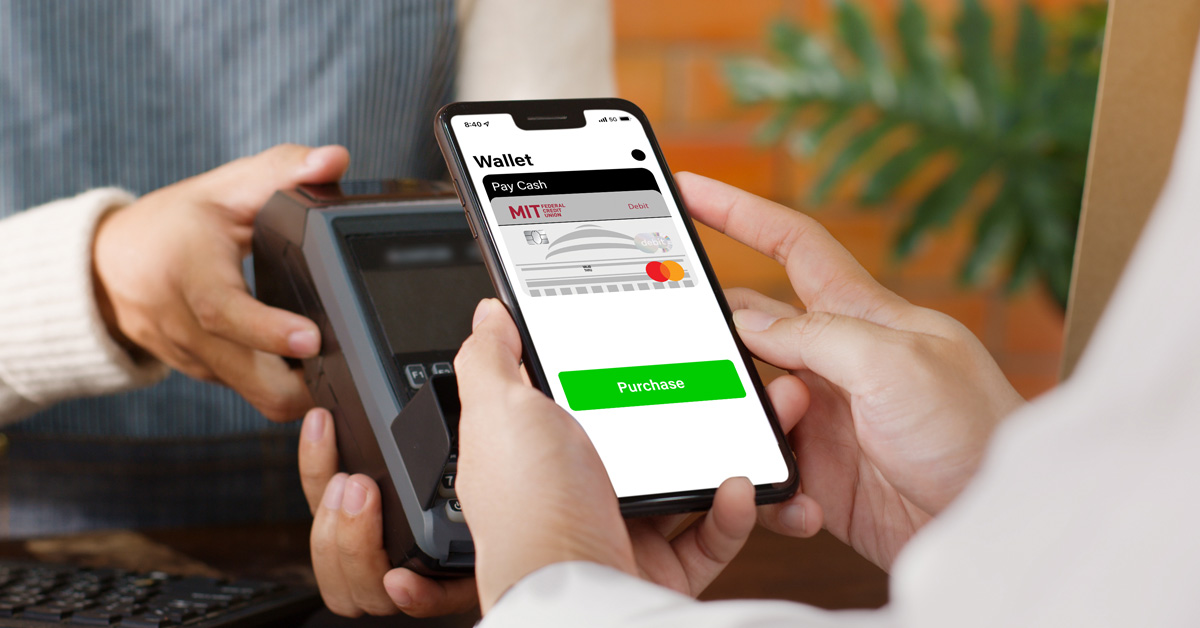How To Stay Safe With The Wallet Of The Future
Apple Pay, Samsung Pay and other mobile wallets are revolutionizing the checkout experience by blending two developments in payment infrastructure to save you time: near-field communication (NFC) and token encryption.
Approximately one-third of all payment terminals nationwide have been updated to accept Apple Pay. It works on phones equipped with the necessary NFC equipment. If you have an iPhone as recent as an iPhone 6 or newer, you can use the preinstalled Passport app. There are simple, on-screen instructions for adding a debit or credit card. You can even add your MIT Federal Credit Union card!
Samsung Pay is structured similarly and will work on select Samsung Android devices. However, Samsung has incorporated magnetic secure transmission (MST) technology, too. Hold a phone against a payment terminal and it emits a signal that simulates the magnetic strip on a debit or credit card. In terms of convenience, this means you can use Samsung Pay on almost any payment terminal. The only situation where Samsung Pay won’t work is when you need to insert your card into a slot.
Mobile wallets transfer money from customer to vendor via tokenization – the use of a non-secure piece of data to stand in place of a secure one.
When you make a payment with one of these services, the app creates a token – a random series of numbers – corresponding to your account, along with a one-time security key. It transmits that data to the payment terminal, which sends that token to the “token vault,” a secure database linking these tokens to actual accounts.
If the security key is correct, the token vault transmits a charge directly to the linked cards and returns a verification of funds to the payment terminal. Since the token vault is hosted at the payment processor, the point-of-sale terminal never sees your card information.
In an ordinary payment, the terminal reads your card information and then transmits it to the payment processor, which then transmits it to your financial institution. This means your information is stored in three different places.
With tokenization, though, your information is seen only by the payment processor and your financial institution. That’s fewer points of vulnerability for your data. This also means that Apple and Samsung have no idea what purchases you’re making. For fans of internet privacy, this is heartening news.
There are other layers of security involved in these services, too. To use Apple Pay, you’ll need to use TouchID, FaceID or input your PIN. For Samsung Pay, you’ll have to authenticate your fingerprint, input a PIN or confirm an iris scan.
Whether you’re an Apple fan or a Samsung supporter, mobile wallets are an efficient, secure way to pay. Download the app, link your MIT Federal Credit Union card, and start leaving your wallet at home!
« Return to "Blog"

All About Blockchain
The decentralized and distributed ledger technology underlying Bitcoin, known as blockchain, holds the potential to revolutionize financial systems.

How Do Personal Loans Work? A Beginner's Guide
In this beginner’s guide, we’ll break down everything you need to know about personal loans and how to decide if one is right for you.

The Benefits of Using Mobile Wallet
Tired of digging out cash or cards at the checkout? Try mobile wallet!





